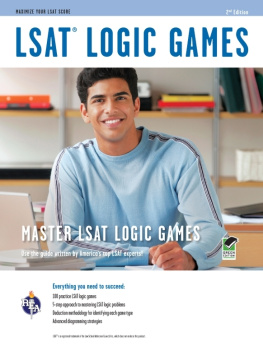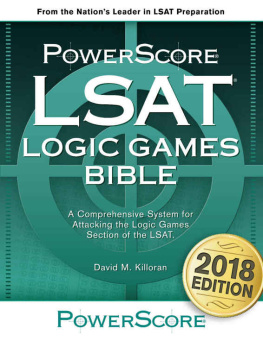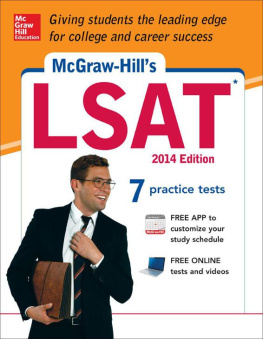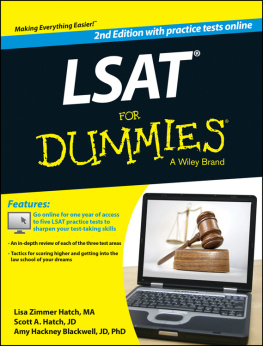Curvebreakers - McGraw-Hills LSAT, 2011 Edition
Here you can read online Curvebreakers - McGraw-Hills LSAT, 2011 Edition full text of the book (entire story) in english for free. Download pdf and epub, get meaning, cover and reviews about this ebook. City: New York, year: 2010, publisher: McGraw-Hill, genre: Children. Description of the work, (preface) as well as reviews are available. Best literature library LitArk.com created for fans of good reading and offers a wide selection of genres:
Romance novel
Science fiction
Adventure
Detective
Science
History
Home and family
Prose
Art
Politics
Computer
Non-fiction
Religion
Business
Children
Humor
Choose a favorite category and find really read worthwhile books. Enjoy immersion in the world of imagination, feel the emotions of the characters or learn something new for yourself, make an fascinating discovery.

- Book:McGraw-Hills LSAT, 2011 Edition
- Author:
- Publisher:McGraw-Hill
- Genre:
- Year:2010
- City:New York
- Rating:3 / 5
- Favourites:Add to favourites
- Your mark:
- 60
- 1
- 2
- 3
- 4
- 5
McGraw-Hills LSAT, 2011 Edition: summary, description and annotation
We offer to read an annotation, description, summary or preface (depends on what the author of the book "McGraw-Hills LSAT, 2011 Edition" wrote himself). If you haven't found the necessary information about the book — write in the comments, we will try to find it.
McGraw-Hills LSAT, 2011 Edition — read online for free the complete book (whole text) full work
Below is the text of the book, divided by pages. System saving the place of the last page read, allows you to conveniently read the book "McGraw-Hills LSAT, 2011 Edition" online for free, without having to search again every time where you left off. Put a bookmark, and you can go to the page where you finished reading at any time.
Font size:
Interval:
Bookmark:
McGRAW-HILLs LSAT
Curvebreakers
2011 EDITION


Copyright 2010, 2009, 2008, 2007, 2006, 2005 by The McGraw-Hill Companies, Inc. All rights reserved. Except as permitted under the United States Copyright Act of 1976, no part of this publication may be reproduced or distributed in any form or by any means, or stored in a database or retrieval system, without the prior written permission of the publisher.
ISBN: 978-0-07-174085-2
MHID: 0-07-174085-6
The material in this eBook also appears in the print version of this title: ISBN: 978-0-07-174084-5, MHID: 0-07-174084-8.
All trademarks are trademarks of their respective owners. Rather than put a trademark symbol after every occurrence of a trademarked name, we use names in an editorial fashion only, and to the benefit of the trademark owner, with no intention of infringement of the trademark. Where such designations appear in this book, they have been printed with initial caps.
McGraw-Hill eBooks are available at special quantity discounts to use as premiums and sales promotions, or for use in corporate training programs. To contact a representative please e-mail us at bulksales@mcgraw-hill.com.
This publication is designed to provide accurate and authoritative information in regard to the subject matter covered. It is sold with the understanding that neither the author nor the publisher is engaged in rendering legal, accounting, or other professional service. If legal advice or other expert assistance is required, the services of a competent professional person should be sought.
From a Declaration of Principles jointly adopted
by a Committee of the American Bar
Association and a Committee of Publishers
TERMS OF USE
This is a copyrighted work and The McGraw-Hill Companies, Inc. (McGraw-Hill) and its licensors reserve all rights in and to the work. Use of this work is subject to these terms. Except as permitted under the Copyright Act of 1976 and the right to store and retrieve one copy of the work, you may not decompile, disassemble, reverse engineer, reproduce, modify, create derivative works based upon, transmit, distribute, disseminate, sell, publish or sublicense the work or any part of it without McGraw-Hills prior consent. You may use the work for your own noncommercial and personal use; any other use of the work is strictly prohibited. Your right to use the work may be terminated if you fail to comply with these terms.
THE WORK IS PROVIDED AS IS. McGRAW-HILL AND ITS LICENSORS MAKE NO GUARANTEES OR WARRANTIES AS TO THE ACCURACY, ADEQUACY OR COMPLETENESS OF OR RESULTS TO BE OBTAINED FROM USING THE WORK, INCLUDING ANY INFORMATION THAT CAN BE ACCESSED THROUGH THE WORK VIA HYPERLINK OR OTHERWISE, AND EXPRESSLY DISCLAIM ANY WARRANTY, EXPRESS OR IMPLIED, INCLUDING BUT NOT LIMITED TO IMPLIED WARRANTIES OF MERCHANTABILITY OR FITNESS FOR A PARTICULAR PURPOSE. McGraw-Hill and its licensors do not warrant or guarantee that the functions contained in the work will meet your requirements or that its operation will be uninterrupted or error free. Neither McGraw-Hill nor its licensors shall be liable to you or anyone else for any inaccuracy, error or omission, regardless of cause, in the work or for any damages resulting there from. McGraw-Hill has no responsibility for the content of any information accessed through the work. Under no circumstances shall McGraw-Hill and/or its licensors be liable for any indirect, incidental, special, punitive, consequential or similar damages that result from the use of or inability to use the work, even if any of them has been advised of the possibility of such damages. This limitation of liability shall apply to any claim or cause whatsoever whether such claim or cause arises in contract, tort or otherwise.
Editor
Chris Keenum
Special Thanks
Nick Degani
Wendy Hanks
Patrick Keenum
Evan Magers
Matt Ott
Josh Salzman
Aman Solomon
Additional Thanks
Dave Gaston
Nathan Kitchens
Ken Reinker
The Whigs
McGRAW-HILLs LSAT
GETTING STARTED
INTRODUCTION TO THE LSAT
In this chapter you will learn:
When to take the LSAT and how to register for the test
The format of a typical LSAT
How the LSAT is scored
The three main types of LSAT questions
Why it makes sense to guess if you cannot answer a question
The Law School Admission Test (LSAT) is required for admission by more than 200 law schools in the United States and Canada that are members of the Law School Admission Council (LSAC). Many law schools that are not LSAC members also require applicants to take the LSAT.
According to the LSAC, the LSAT is designed to measure certain skills that are considered vital to success in law school. These include the ability to read and understand complicated text passages, to draw reasonable inferences and conclusions from them, to think critically, and to evaluate logical arguments.
When the LSAT Is Given. The LSAC administers the LSAT four times each year at designated test centers in the United States and Canada and throughout the world. The four test dates are typically on Saturdays in February, June, October, and December. Many law schools require that you take the LSAT by December if you are applying for admission the following fall. However, applicants are often advised to take the test earlier than December, that is, in October or even June of the year before they expect to begin law school.
How to Register. You can register for the LSAT by mail, by telephone, or online. A registration fee is charged. Regular registration takes place until approximately 30 days before the test date. Late registration is allowed until about three weeks before the test date, but a higher fee is charged. You cannot register for the test on the day it is given.
To register, contact the Law School Admission Council at the following address:
Law School Admission Council
662 Penn Street
Box 2000
Newtown, PA 18940-0998
Tel. (215) 968-1001 (service representatives are available on weekdays only)
For online registration: www.LSAC.org
Registration forms are included in the LSAT and LSDAS Registration/Information Book, a booklet that is usually available in college and university guidance offices or by mail from the LSAC. If you are registering by mail, fill out the forms in the booklet and mail them in the enclosed, preaddressed return envelope. Faxed registration forms are not accepted.
When you register, you will have the opportunity to select a first-choice and second-choice test center located near you. If both centers you select are full or unavailable, the LSAC will assign you to another center located as near to you as possible.
Alternative Testing Arrangements. If you observe Saturday Sabbaths, you may take the LSAT on the Monday following the regular Saturday testing date. To do so, you must submit to the LSAC a letter from your rabbi or minister on official stationery confirming your religious affiliation.
Special testing accommodations are also available for test takers with documented disabilities. To request these arrangements, obtain an accommodations request packet by contacting the LSAC either by mail or online. The LSAC urges test takers who wish to request special testing accommodations to do so well in advance of the registration deadline.
Next pageFont size:
Interval:
Bookmark:
Similar books «McGraw-Hills LSAT, 2011 Edition»
Look at similar books to McGraw-Hills LSAT, 2011 Edition. We have selected literature similar in name and meaning in the hope of providing readers with more options to find new, interesting, not yet read works.
Discussion, reviews of the book McGraw-Hills LSAT, 2011 Edition and just readers' own opinions. Leave your comments, write what you think about the work, its meaning or the main characters. Specify what exactly you liked and what you didn't like, and why you think so.




